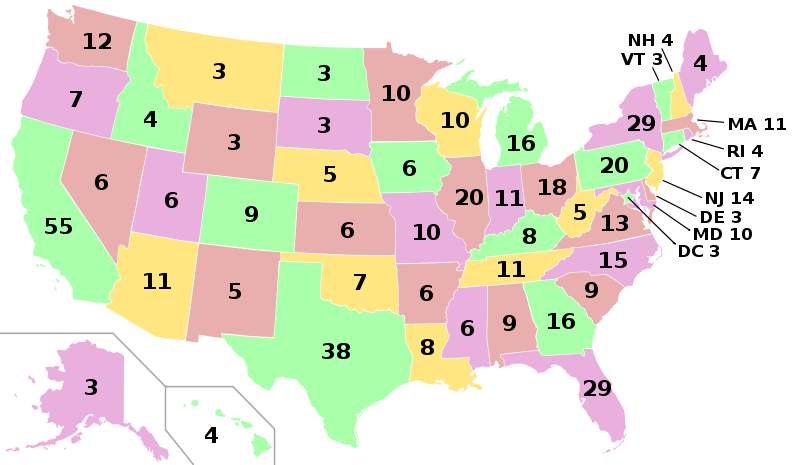| Line 53: | Line 53: | ||
<br> | <br> | ||
| − | + | In addition, The District of Columbia and all states, except Nebraska and Maine follow winner-takes-all rule<br> | |
Violating of equal vote privilege: | Violating of equal vote privilege: | ||
| Line 63: | Line 63: | ||
Reference. | Reference. | ||
| + | |||
| + | [n] | ||
| + | |||
| + | [http://www.archives.gov/federal-register/electoral-college/faq.html#wtapv]<br> | ||
| + | |||
| + | [n] | ||
---- | ---- | ||
Revision as of 12:56, 27 November 2013
The constitutional right of equal vote vs weighted voting: historical events and the Banzhaf power index
A team project for MA279, Fall 2013
Team members: Shuaijia Dai, Bo Ling, Rustam Orazaliyev, Matthew D Parr, Christopher Patrick
Don't copy and paste, the page goes mad. Make sure to paraphrase everything you write and include references for it.
I. Introduction. (Bo Ling)
(SECTION 2. The right of citizens of the United States to vote and to participate in elections on an equal basis shall not be denied or abridged by the United States or any State on account of political-party affiliation or prior condition of incarceration.)
II. Equal vote definition, example, where it is used. Equal voting Historical Timeline in the USA. (Christopher Patrick)
III. Weighted voting definition, example, where it is used. When the US started to use it
A Look at Weighted Voting
A weighted voting system is one in which the players of such a system hold varying amounts of votes. This differing amount of votes for each player is considered the voting weight of the player. It is completely likely that different players will hold differing weights. We say the voter i has a weight of wi. These weights are important when trying to decide the winner of an election. The quota q is the minimum amounts to win said election, and since the voting system is weighted, only certain combinations of wi will decide a winner. This quota should be at least a majority of the sum of wi to prevent ties, and it is less or equal to the sum of the weights.
An example of weighted voting used today comes from the World Bank. The World Bank uses weighted voting with its members and board according to the amount of shares the member holds. Each member receives one vote per share of capital stock he or she holds. Therefore, those with higher share holdings will own a higher weight when voting. In fact, this is the most common use of weighted voting today. People involved with shareholder meetings, such as a businesses board of directors, need a voting system that reflects a player’s involvement in that organization. Those with higher shares and investments in a company tend to want to have more weight assigned to their votes in board meetings. Although this is the most common example of weighted voting, this system has emerged in the world of politics as well, especially in the United States.
Today, the United States of America uses a weighted voting system in what most consider its most important election–the presidential election. Weighted voting entered mainstream American politics with the creation of the Electoral College in 1787. In the Electoral College system, each state is allotted a certain number of electors representative of the state’s congressional delegation. Essentially, the Electoral College acts as a weighted voting system to elect the President. There are 56 players: 50 states, the District of Columbia, three Nebraska congressional districts, and two Maine congressional districts. The number of electors assigned to each player acts as the player’s weight, and these weights vary as each state could have a different congressional delegation. The weights range from 1 (for individual congressional districts) to 55 (for California’s delegation), and the quota of 270 is the simple majority of the sum of the weights, 538.
Clearly, the weighted voting system is implemented all over the world in differing organizations and governments. However, this system brings with it more interesting things to consider. Since the weights of players can be all different, a critical question arises. Who controls elections? This leads to the study of what a player’s power is in such a voting system. One of the most common ways to determine power is through the Banzhaf Power Index. A study of this index is essential to understanding weighted voting systems.
References:
[www.math.upenn.edu/~ahughes/p170/fapp/ch11.ppt]
IV. Banzhaf index, and Banzhaf index relation to our historical events. (Shuaijia Dai)
V. Violation of equal vote by weighted voting and historical events.
Nowadays, social inequality is considered to be one of the biggest problems the modern society faces. Therefore, the majority of developed countries, especially the US launch programs and invest big amounts of money to fight with social inequality. However, what the US government forgets about is its own voting system. The United States of America uses weighted voting system in the presidential election. Considering the fact how important the principle of equality nowadays is, the use of weighted voting system in such a developed country is at least unexpected.
As it can be seen on the following image, states and District of Columbia represent players and have different weights.
In addition, The District of Columbia and all states, except Nebraska and Maine follow winner-takes-all rule
Violating of equal vote privilege:
Something like: "George W. Bush took every single electoral-college vote in the South and found a majority of his electoral-college votes there. Meanwhile, the majority of African Americans, more than 20 million, live in the South and gave A1 Gore better than go percent of their vote. Yet because of the winner-take-all method of distributing electoral-college votes, black votes in the South-even when counted-had zero impact on the election."
VI. Conclusion. (Bo Ling)
Reference.
[n]
[n]


